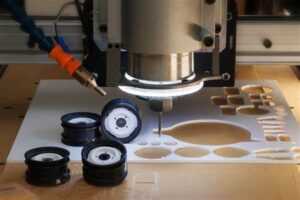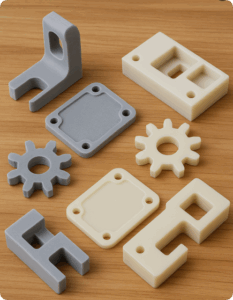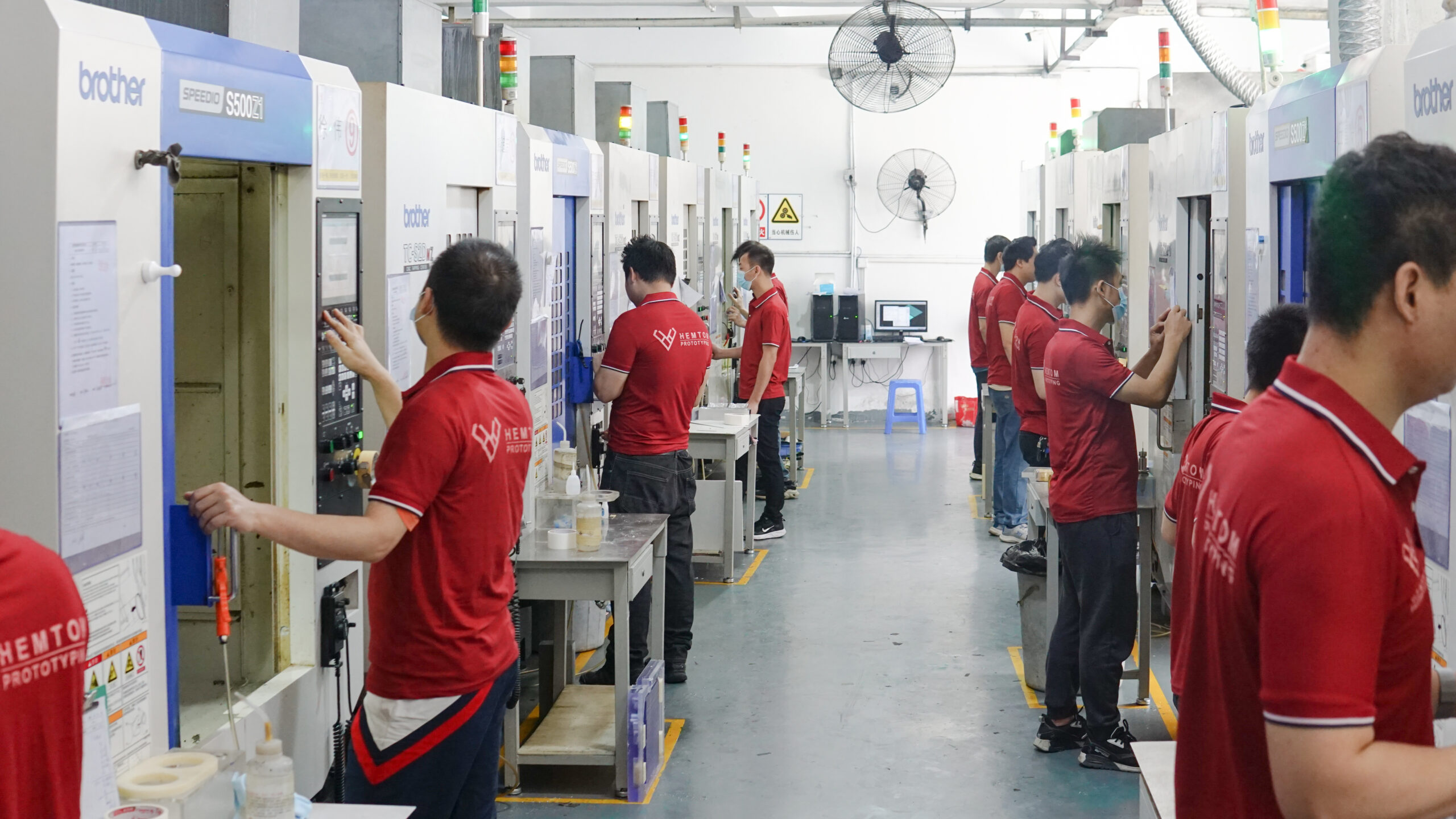CNC rapid prototyping uses computer-controlled machines for the creation of physical models. CNC stands, for computer numerical control. It means the machines are able to follow a series of instructions called G-codes in order to cut, carve or engrave various materials with great precision and speed.
In many industries, including consumer electronics, aerospace, automotive, and medical, CNC rapid prototyping has become a standard practice. CNC rapid prototypes are also useful to inventors and entrepreneurs who want to test out their ideas and design in real life.
CNC rapid prototypes are a great choice if you’re looking for an affordable, fast and reliable way to bring your design ideas to life. There are a few things to consider before ordering CNC rapid prototyping. We will discuss the following topics in this article:
- What are the benefits and challenges of CNC rapid prototyping
- What types of CNC machines and materials are available for CNC rapid prototyping
- How to prepare your design files for CNC rapid prototyping
- How to choose the best CNC rapid prototyping service provider for your project
- How to evaluate the quality and performance of your CNC rapid prototyped parts
What are the Benefits and Challenges of CNC Rapid Prototyping
You should carefully consider CNC rapid protyping’s benefits and drawbacks before you order services. Here are a few pros and con of CNC rapid prototypes:
- Benefits:
- High quality: CNC Rapid Prototyping creates parts with a high level of dimensional accuracy, surface finishing, and structural integrity. With CNC rapid prototyping, parts can be produced with complex geometries that would otherwise be impossible to achieve.
- CNC rapid prototypes can be used with virtually any material, whether it is metal, plastic or wood. It is possible to mix and combine different materials in order to create hybrid components with different properties.
- Fast turnaround: CNC Rapid Prototyping can create components in hours or days depending on the complexity of the part and the quantity. CNC rapid prototypes can reduce the number of iterations or revisions needed, since the design can easily be validated and tested.
- CNC rapid prototypes can be cost-effective, especially in low- to medium-volume production. CNC rapid prototyping saves money on waste materials, tooling and labor costs.
- Challenges:
- CNC rapid prototypes can be expensive, especially in high-volume production. CNC rapid prototypes also require a high investment in CNC machines and software. For some users, this can be prohibitive.
- High complexity. CNC rapid prototyping is more complex and difficult to do than other methods of prototyping, since it requires advanced software, hardware and programming skills in order to operate and control CNC machines. It is also important to plan and prepare the design files more carefully for CNC rapid prototypes, because any error could result in an unusable or faulty part.
- CNC rapid prototypes can pose a higher safety risk than other prototyping techniques. This is because they involve high-speed, temperature, and pressure operations which can result in injuries or damage when not handled properly. The safety measures and regulations for CNC rapid prototypes are also more stringent, such as wearing protective equipment, following instructions, or maintaining the machine.
What Types of CNC Machines and Materials are Available for CNC Rapid Prototyping
CNC rapid prototypes can be made using many different materials and machines depending on their size, shape and complexity. Some of the common types are:
- CNC milling: These machines remove material using a rotating cutter. CNC milling can create parts that have complex geometries or features, like holes, pockets, slots, or curves. The CNC milling machine can have different configurations such as 3-axis (three axes), 4-axis (four axis), or 5-axis (five axis) depending on how the cutting tool moves.
- CNC turning machine: This machine uses a stationary cutting device to remove material from rotating workpieces. CNC turning machine can produce parts of cylindrical or circular shapes such as rods, tubes, or shafts. CNC turning machines are available in different configurations such as 3-axis or multi-axis depending on how many tools they can handle at once.
- CNC routers are machines that use a rotating cutting tool to carve or cut flat materials. CNC routers allow you to create parts with 3D or 2D shapes. For example, signs, panels and molds. The configuration of CNC routers is also different, such as 3-axis (4-axis), 5-axis (5-axis), depending on the amount of directions in which the cutting tools can move.
- CNC plasma cutting machines: These machines cut through metal using a plasma jet. CNC plasma cutting machines can produce parts with 2D forms, such as frames, brackets and plates. CNC plasma cutters can be configured in different ways, such as 2-axis (3-axis) or 4-axis (depending on how many directions plasma can move).
- CNC waterjets are machines that use high-pressured water with abrasive materials to cut through any workpiece. CNC waterjet machines can cut parts with 2D and 3-dimensional shapes, like gears, seals or sculptures. Different configurations of CNC waterjets exist, including 2-axis and 3-axis.
CNC rapid prototyping has the advantage of being able to work with many different materials. These include metals, plastics and wood. The most common materials used for CNC rapid prototypes are:
- Metals: Metals have high strength, durability, and resistance to heat and corrosion. Metals are used to make parts that need high conductivity or stiffness or strength. Aluminum, steel, stainless-steel, brass, copper and titanium are some of the metals that are commonly used for CNC rapid prototypes.
- Plastics is lightweight, flexible and easy to form. Plastics are used in parts that need to be low-cost, versatile, or have an aesthetic appeal. Some of the most common plastics used for CNC rapid prototypes are ABS, acrylics, nylon, polycarbonate and PVC.
- Wood is renewable and biodegradable. Furniture, toys, and art can all be made from wood. Pine, oak, maple and plywood are some of the most common types of wood used for CNC rapid prototypes.
How to Prepare Your Design Files for CNC Rapid Prototyping
Final step to preparing your design files before ordering CNC rapid prototype services is to prepare them for CNC rapid protyping. The design files you use for your CNC rapid prototype project must be complete, clear and compatible with CNC machines. Here are a few tips for preparing your design files to be used in CNC rapid prototyping.
- Use a suitable software for CAD: It is important to choose a software that will allow you to create 3D parts of your part with all the features and details required. Use a CAD program that exports your 3D model in a file format that CNC machines can understand, like STL, STEP or IGES.
- Optimize your design. You should optimize your design in order to make it suitable for CNC rapid prototypes. This includes reducing complexity, simplifying geometry and eliminating unnecessary features. Optimize your design in order to save time, money, and materials for CNC rapid prototyping. This includes minimizing size, optimizing efficiency, and selecting the right material and finish.
- Check your design. You should check your design to see if there are any issues or errors that could affect the CNC rapid prototype process. These include gaps, overlaps or interferences. Check your design to see if there are any constraints or specifications that CNC machines must follow. This includes dimensions, tolerances and orientations. Use a CAD program or online service to validate and check your design before sending to the CNC rapid prototype service provider.
How to Choose the Best CNC Rapid Prototyping Service Provider for Your Project
Outsourcing CNC rapid prototyping to a service provider is an option if your resources or expertise are not sufficient. There are many CNC rapid prototyping services, but not all of them can meet the needs and expectations of your project. These are factors you should consider when choosing the right CNC rapid prototyping provider for your project.
- Experience: You should check the reputation and experience the CNC rapid-prototyping service provider. For example, you can ask them how long they’ve been in the business, which types of projects and feedback they’ve received from previous clients. You can also request samples or references from their previous work to determine the quality and consistency.
- Capability – You will need to know the capacity and capability of the service provider for rapid prototyping CNC. For example, you should ask what CNC machines and materials they work with and in what quantities. To see if the company can meet deadlines and your budget, you can also request a quote.
- Communication: You will need to assess the service provider’s communication and customer service. Check how accessible they are, how quick they are in responding to your queries, and whether they fully understand your requirements. You can also request a contract detailing the service’s scope, terms and conditions to avoid any confusion.
- You must check the quality, reliability, and accuracy of the CNC rapid-prototyping service provider. Check how well they manage any errors and defects and how they protect the confidentiality and intellectual property of your company. Ask for a quality certification or assurance to verify their standards and procedures.
How to Evaluate the Quality and Performance of Your CNC Rapid Prototyped Parts
Evaluation of the parts’ quality and performance is the last step to take after you have received your CNC rapid-prototyped parts. It is important to verify that the parts are in line with your expectations and design specifications. Also, you need to make sure that the parts meet your requirements. Here are some tips about how to evaluate your CNC rapid-prototyped parts for quality and performance:
- Check the parts visually. You should inspect each part visually to check for any defects, including cracks, scratches and deformations. Ensure that you inspect all parts visually to check for discrepancies and deviations. This includes dimensions, tolerances, and orientations. You can measure the parts using a ruler, micrometer or caliper and compare it to your design files.
- Test the parts in their functional state: You should test the parts in their functional state to check for any issues, problems, or noises such as malfunctions. You must also test for the performance of any part, including speed, power and durability. Using different tools and methods like sensors, meters, software or other devices, you can test the parts to compare them with design goals.
- Collecting feedback from the user: It is important to get feedback from your users about their opinions, suggestions, and dislikes. You need to get feedback from users on any issues or concerns, like usability, appeal, or comfort. You can use different tools and methods such as surveys or interviews to collect user feedback and compare it with your expectations.
Conclusion
CNC rapid prototyping uses computer-controlled machines for the creation of physical models. CNC rapid prototyping offers many advantages, including high quality, a wide range of materials, a quick turnaround time, and cost effectiveness. CNC rapid prototyping has its challenges as well, including high costs, complexity and safety risks.
You should know the advantages and challenges of CNC Rapid Prototyping before you decide to order the service. Also, you must be aware of the types of CNC machines, materials, and software that are available to you for CNC Rapid Prototyping.



